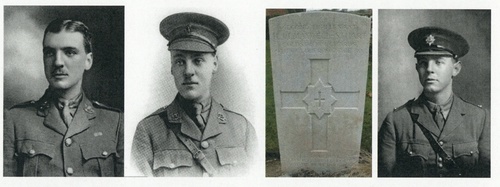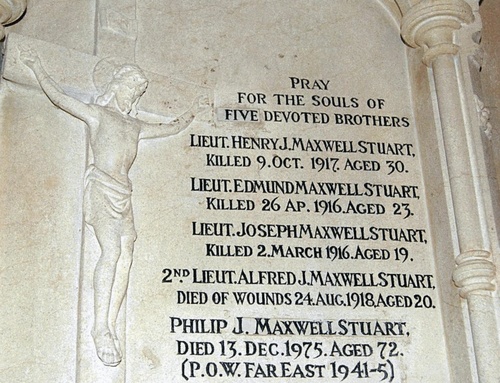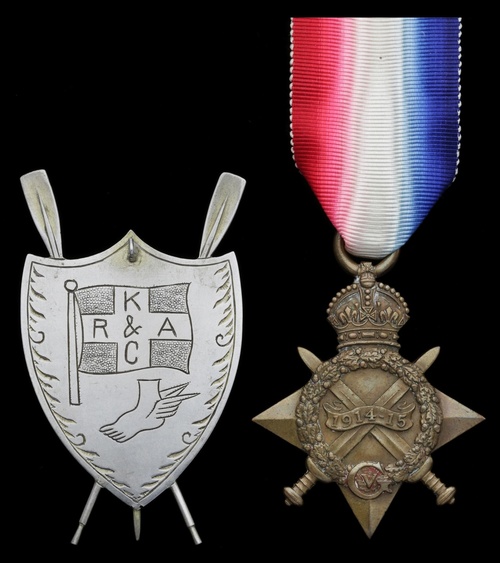Auction: 20001 - Orders, Decorations and Medals - conducted behind closed doors
Lot: 235
The poignant 1914-15 Star awarded to Captain W. J. P. Maxwell-Stuart, Royal Sussex Regiment: a nephew of the Duchess of Norfolk who, from a family of seven brothers, was one of five who fought during the Great War - with four of those five never returning to the family home at Arundel
1914-15 Star (2. Lieut: W. J. P. Maxwell-Stuart. R. Suss: R.), good very fine
William Joseph Peter Maxwell-Stuart was born on 22 July 1895 at Sunninghill, Berkshire, the eighth of eleven children to the Honourable Mary Anne Constable-Maxwell, daughter of William Constable Maxwell, 10th Lord Herries of Terregles, and Edmund Joseph Constable Maxwell-Stuart, the son of the Honourable Henry Constable Maxwell Stuart of Traquair and Terregles. Through his father's lineage, William and his siblings were nephews of Herbert Maxwell Stuart, Laird of Traquair, whose ancestors were staunch Catholic supporters of Mary Queen of Scots - and the later Jacobite Cause - whilst on his mother's side of the family they were the neices and nephews of Gwendolen Constable-Maxwell, second wife of Henry Fitzalan-Howard, the fifteenth Duke of Norfolk. He spent his early childhood living at Batworth Park, in the shadow of Arundel Castle.
Educated at Stoneyhurst College in the footsteps of his three younger brothers and a certain Maurice James Dease - who later earnt the first posthumous Victoria Cross of the Great War - William served as a Cadet in the College Contingent Junior Division O.T.C. and was subsequently commissioned 2nd Lieutenant in the 4th (South Downs) Battalion, Royal Sussex Regiment on 29 October 1914 (London Gazette 13 November 1914, refers). Posted to 'D' Company which was largely composed of local men from Arundel and Angmering, William spent the remainder of 1914 and spring of 1915 training his men at barracks in Bedford.Wounded in action
Sailing from Devonport to Alexandria aboard H.M.T. Ulysses, then on to Port Said and Mudros Bay, the 4th Battalion Royal Sussex Regiment eventually landed on the pristine white sand of Suvla Bay at 4.15am on 9 August 1915. Within hours they attempted to take Hill 70, but received heavy casualties from enfilade fire. By 11.20pm the Battalion's strength had been reduced to 250 men, with 1 officer killed, 3 wounded, and 11 other-ranks killed and 60 wounded (The 4th Battalion War Diary, refers). They then spent the next few days attempting to consolidate meagre gains and repair trenches before being relieved by the York and Lancaster Regiment on 12 August.
On 25 August 1915, the Bognor Regis Observer reported the 'well-known' William Maxwell-Stuart as wounded in action. He returned from hospital and joined his Battalion on the southern Slopes of Lala Baba on 17 November 1915 (Battalion War Diary, refers), but was evacuated from the peninsula with the remainder of the 53rd Division on 13 December 1915, reaching Mudros harbour at 10am the following morning.
Family tragedy
Having survived his baptism of fire at Suvla, it wasn't long before news began to filter through to William regarding the deaths of his brothers. The first to be killed in action was his younger brother - and ninth child of the family - Lieutenant Joseph Maxwell-Stuart:
'Great sympathy has been extended to the parents of Lieutenant J. Maxwell-Stuart, 3rd Duke of Wellington's Horse, who was killed near the Ypres-Comines Canal on March 2nd (1916), when his regiment was leaving the trenches which had been heavily bombarded' (The Mid-Sussex Times, 14 March 1916, refers).
Less than two months later, news was received of the loss of elder brother )and seventh child) Lieutenant Edmund Joseph Maxwell-Stuart, who was killed in action on 26 April 1916 in France. Transferred from the East Yorkshire Regiment to the Royal Engineers, he wrote a short article a few weeks before his death which was later published in The Stoneyhurst Magazine:
'I am in a tunnelling company of the R.E. (175th Coy. R.E. 2nd Army, B.E.F., France). I am in this death-trap known as 'The Salient,' burrowing tunnels under Hun trenches, and in fact looking for trouble. I am overdue for leave, but all leave is stopped for the present. Five long shell-ridden months I've been here, and I feel ten years older than when I landed in France.'
A letter written by his commanding officer added:
'I would have you know that all who knew him admired and loved your son as a fine soldier and a true gentleman' (The West Sussex Gazette, refers).
The following year, William learned of the death of elder brother and the fourth child, 2nd Lieutenant Henry Joseph Ignatius Maxwell-Stuart, who was killed in action whilst serving with the 3rd Battalion Coldstream Guards on 9 October 1917. Sadly, his death occurred a matter of days before the marriage of the eldest brother, Mr. Francis Joseph Maxwell-Stuart to Miss Dorothy May Hartley of Billesdon-Coplow, Leicestershire, at St. James' Church, Spanish Place. The ceremony thus proceeded 'very quietly' (The Sussex Agricultural Express, refers).
On 20 August 1918 William lost a fourth brother to the war, the youngest brother and tenth child, Lieutenant Alfred Joseph Maxwell-Stuart. Having been best man at Francis's wedding, Alfred died of wounds received in action during the Battle of Albert whilst serving with the 1st Battalion, Coldstream Guards. The temperament of Alfred and circumstances relating to his death were later published in The Stoneyhurst Magazine:
'He was somewhat shy and retiring in character, but was a favourite with all. Owing to an attack of trench fever, and other slight ailments, he had not been in the trenches save for one or two short periods, until within a fortnight of his death. His fatal injuries were received on August 21st, during the successful advance of the Guards on that date. Though slightly wounded earlier in the engagement, he remained with his men, urging them on, and giving them an example of absolute fearlessness in the presence of the greatest danger, until he was struck down, mortally wounded at Moyenneville.
He had received several bullet-wounds, both his legs were injured, the forearm broken and gangrene poisoning had already set in. He gradually sank and quietly expired on August 24th.
He sent messages to his parents, giving them his love, and telling them not to worry as he was all right.'
Ultimate sacrifice
The loss of four sons from such a prominent Sussex family drew significant press attention across the United Kingdom. On 28 August 1918 the Dundee Evening Telegraph published an article headlined, 'Lost Four Sons in the War.' In consequence, Mary and Edmund Maxwell-Stuart decided to relocate to East Lulworth in Dorset and in October 1919 the family home of Batchworth Park was consigned to auction by Wyatt & Son, Arundel. The auction also included the full contents of the house including household furniture, a 'handsome 6ft. 5in. carved mahogany sideboard', an oil painting attributed to J.M.W. Turner, outdoor effects and a lawn mower (The Chichester Observer, 8 October 1919, refers).
In 1920, a memorial to the four brothers was unveiled at the Cathedral of our Lady and Saint Philip Howard in Arundel. It originally read 'Pray for the souls of four devoted brothers,' but this was amended to 'five' in 1976 upon the death of the youngest brother and eleventh child, Philip Joseph Maxwell-Stuart, who suffered all his life from health complications associated with his four years in a Japanese P.O.W. camp. The sacrifice made by these young men and a further 89 men of Arundel was commemorated recently at the 100th Anniversary of the Armistice when 93 perspex silhouettes were placed in the pews of the Cathedral, driven by the desire of town councillor and former Mayor, Michael Tu (The Littlehampton Gazette, refers).
Little more is known regarding the later life of William. He became a well-known ballroom dancer and married Patricia Craven Sykes, daughter of Charles Craven Sykes of Huddersfield, in July 1932. Together, the couple became 'three times holders of the World Championship' (The Leeds Mercury, 8 July 1932, refers), specialising in the waltz, tango, quick step and the rumba (The Banbury Advertiser, refers). Having spent a time living at Banbury, William appears to have returned home to Sussex and died on 3 October 1964 at Chichester; sold with a contemporary Rowing Association badge designed as a shield with crossed oars, with Hermes inspired 'winged foot' design, marked 'Silver' to reverse with vertical wearing pin, approx. 41mm x 65mm, together with extensive copied research including MIC, War Diary entries and newspaper articles.
Subject to 20% VAT on Buyer’s Premium. For more information please view Terms and Conditions for Buyers.
Sold for
£520
Starting price
£70









